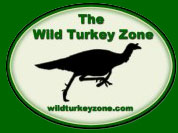Scouting, in my opinion, is
the number one factor for success in turkey
hunting. Scout and study the habits of the
wild turkey as much as possible. If you know
where a gobbler roosts, where he struts and
his favorite places to feed, calling him in
can be very easy. Just remember it is always
easier to call a turkey to a spot he already
wants to go.
Turkeys spread out into different
areas in the spring. Don't expect the place
you saw a huge flock of wintering birds to
have those same birds in the spring. It's
best to get out and scout the last few weeks
before the season starts to see where the
birds have moved. Some areas only hold birds
in the spring while others may only hold them
in the winter.
Think like a hen. Instead
of looking for gobblers when you are out scouting,
find an area that has lots of hens and the
gobblers won't be far away. Look for areas
that have good nesting habitat nearby and
you'll usually find hens and the gobblers
also.
Turkey tracks over 4 1/2"
long are gobbler tracks. Hen usually have
tracks that are 3 1/2" long or less.
The size and
shape of the droppings are also useful in
distinguishing hens and gobblers. Hen droppings
are looped, spiraled or bulbous with a main
stem diameter of 5/16" or less. Jake
droppings are larger with a diameter of around
3/8" and adult gobblers average about
1/2". Male droppings are relatively straight
or J-shaped.
.

